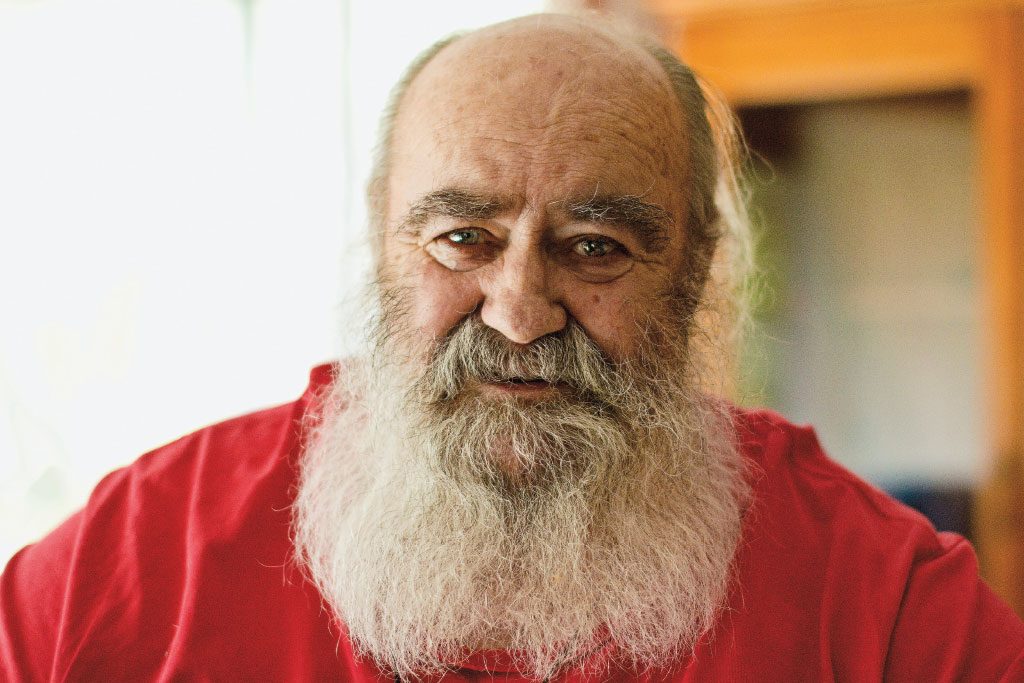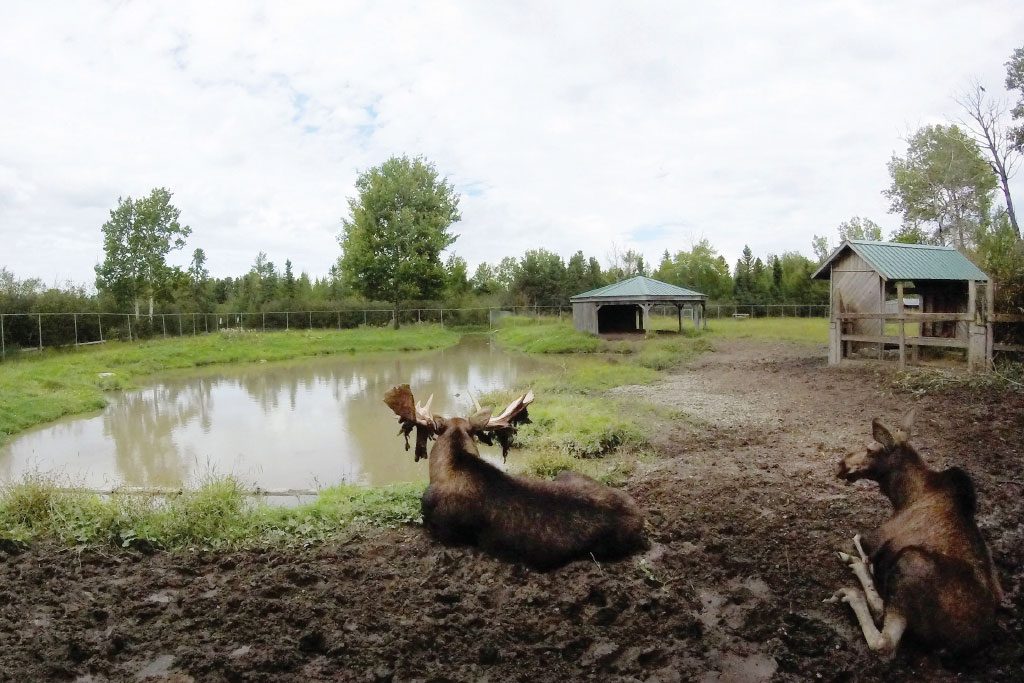As soon as you board the bus that runs more than 600 km between Montréal and Amos, a town in northern Quebéc, the bus’ faux-wood vinyl flooring already has you thinking of trees. You curl up in your seat and roll north overnight, finally opening your eyes on the other side of the 48th parallel, where spruce treetops point toward dawn.
TEXT Sarah Champagne PHOTOS Marie-Frédérique Frigon
The instant you step outside, the smell of conifers, prickly as their needles, sweet as their sap, is, if you pay close attention, always with you. Your first encounter with this expansive northern territory is through your nose. The Abitibi-Témiscamingue region of Québec is half the size of Alabama and twice as big as Belgium.
The sky sparkles as much from aurora borealis as from the mineral-rich subsoil. The small town of Amos acts as the gateway to the North, to the vast Jamesian lands where the Anishinaabeg give way to Crees and hydroelectric dams and, of course, to the boreal forest.
When that much space is available to them, some people can no longer stand to stay cooped up behind closed doors. And this is the hardest thing to bear for Michel Pageau, now that age and illness have confined him to his lair. Crossing the short distance from the back of his living room to the front door, the man who spent 75 years deep in the forest in the company of animals is short of breath when he greets me. He doesn’t fit the bill of solitary or surly hermit stereotype, though he’s familiar with nature’s every odour and whim. His entire life was spent crossing the line that separates humans from animals.

The man who “speaks with wolves” and who “can hear the forest talk,” as described in a documentary about him and in his biography, respectively, is the stuff of legend. His beard, untouched, has now turned completely white. Michel Pageau’s got laughing eyes and still waxes emotional when discussing all the creatures he’s known. After spending a countless amount of time sheltering, nursing, caring for, and setting wild animals free, the former trapper eventually created a sanctuary that bears his name.
Wolves, black bears, beavers, lynx, porcupines, foxes, crows, moose, deer, snowy owls, otters, raccoons, skunks, groundhogs, coyotes: there isn’t a single species of the region’s fauna that hasn’t received care from his considerate hands, those of his wife, and now those of his dedicated successors.
From hunting to protecting
In the early days, Michel Pageau was well-known in Abitibi as a bear and wolf hunter. He would often taxidermy the animals he hunted, trapped, or captured. Locals would call him to help out when they were frightened by the wild bears in their backyards. How did the Michel who killed “more than 300 bears” become the one we suspect can speak to wolves and other creatures; what happened? “Kill a moose and look it in the eyes, you’ll see its entire life unfold. That’s why I stopped,” he says.
Michel’s wife, Louise Pageau, now suffers from Alzheimer’s, though she remains keen on digging up old anecdotes. Pointing at the scratched-up floors their old lodgers used to gnaw on, she says: “I can’t even count the number of animals that have lived with us in this house!” Her favourite will always remain Counou the beaver, whose likeness she now wears around her neck. The beaver used to beg her daughter Nathalie to lift him up onto the sofa so they could watch television together.
In 1986, the adventure which had evolved in an organic and natural way was made official by the sanctuary’s grand opening. Fast-forward three decades later: 25,000 people visit the permanent tenants of the sanctuary every year. The place has definitely changed a lot since the time when there weren’t even any fences. Félix Offroy talks about the patriarch as a friend, colleague, and father-in-law: “He’s a very instinctive person who is incredibly sensitive to feelings, whether they belong to cats, groundhogs, or humans.” He will usually tend to create a moment, an encounter, rather than formally explain what inspires him.
Every creature has their own dedicated lunch box with their name on it; they each have their own unique character and varying degree of independence.

“He loves so much, too much, to an extent that becomes hard to manage. He never really made any big plans, it was more a question of making day-to-day decisions. I took this big ’project’ of his and brought it up to date.” Félix also gave the sanctuary a new mission: the social integration of people afflicted with mental health issues. “Helping people who are struggling by giving them work is something I’m really passionate about.”
“He’s a good manager. I didn’t have the faintest clue about handling money,” adds Michel Pageau. This change of organizational ecosystem doesn’t seem to faze him. On the other hand, he believes that the proliferation of species that used to be rare at these latitudes is a sign that climate change is rearing its ugly head. The world’s future seems upset, but Michel’s ark gets rebuilt every single day.
Lunch before life in the wild
Friday morning, the northern sun is already high and the staff quarters are brimming with food. François Gauthier, one of the animal caregivers, makes his rounds with salmon “sushi” and somewhat wilted lettuce: “Dinner is served!” Many local grocers are more than happy to donate food that is no longer fit for human consumption, to the great delight of the animals.
Every creature has their own dedicated lunch box with their name on it; they each have their own unique character and varying degree of independence. Chewbaka the affectionate porcupine, Evelyne the blind crow who says “Hello, how are you?”, Alex the coyote, Nostradamus the friendly turkey vulture, Yöki the restless fox: those who are permanent residents of the sanctuary have been with humans too long to be able to survive without them. They are orphans or animals wounded by cars, felled trees, or traps, like the two lynx lounging in their pen, who each had to have one of their paws amputated.
The team strives for the precarious balance between human intervention, protection, care, and the end goal of the return to life in the wild. The place’s modus operandi is contrary to that of a zoo. “We provide care to help them return to nature, we aren’t raising them for entertainment,”
explains Marie-Frédérique Frigon, in charge of communications and much more . . . As much through proximity as attachment, she really comes across as the Pageaus’ adopted daughter. Another important piece of a full-blown clan of successors that has nothing of a sect.
She tells her colleagues how 14 baby raccoons were set free the previous day. Nathalie, the Pageau couple’s daughter, on the other hand, will spend part of her Friday night feeding baby groundhogs who’d arrived that very day. “They’re dehydrated, they haven’t had anything to drink for a long time,” she mentions while diligently carrying out her work.


“ We provide care to help them return to nature, we aren’t raising them for entertainment.”
But for now, before lunchtime, we also check up on the three orphan bear cubs that were recently taken in, especially the one who seems depressed by his new living quarters. Which is quite the contrast with a very young moose named Sorbet, who excitedly runs towards Félix in the hopes that it’s time for her feeding. “Daddy, your baby’s hungry!” shouts Mathilde. Barely 17 years old, the Pageaus’ granddaughter has already taken responsibilityfor the small birds and refers to the geese as her protégés.
Her father prepares milk to feed the little one, explaining that with moose, “they make it or break it.” Some of them refuse milk from the hands of a human and end up dying. Others become completely “spoiled,” in the sense that they all but forget that “their mom was a moose,” says Félix.
“For example, we’re going to try and see if the birds of prey can still hunt,” explains Marie-Frédérique. For others, it’s obvious that captivity remains the only option, like in the case of Guedule the goose. Demonstrating an extraordinary attachment for Michel Pageau, the bird would follow his every step until he “introduced” her to a cow who would later become her friend.
These privileged relationships with wildlife are rarely dangerous. “Nothing has ever happened. My only scar was caused by a hare,” laughs Michel. Animal behaviour remains nonetheless difficult to predict and varies with every person who turns up.

For example, Marie-Frédérique Frigon has a very good connection with the sanctuary’s she-wolves. During her studies in Montréal, she was afraid they would forget her, but they still continue to greet her, snapping their jaws when she approaches. An elderly 14-year-old wolf, “the big one,” is the only one who hasn’t budged since yesterday. He was born in captivity and prefers to flee rather than risk confrontation, until a serious case of arthritis slows him down.
Michel Pageau has slowed down significantly as well. He no longer goes out to sculpt bones or
antlers in his “camp,” a little building he has used as a workshop for decades. When you push the door open, stuffed birds stare at you, including a great blue heron that’s missing a few feathers.
Memories cry out, caw, crack, chirp, squeak, growl, and sing at the top of their lungs. “If someone put a camera in my head, they’d see every single animal that came through here.” And his bestiary is bound to live on for many years to come ■